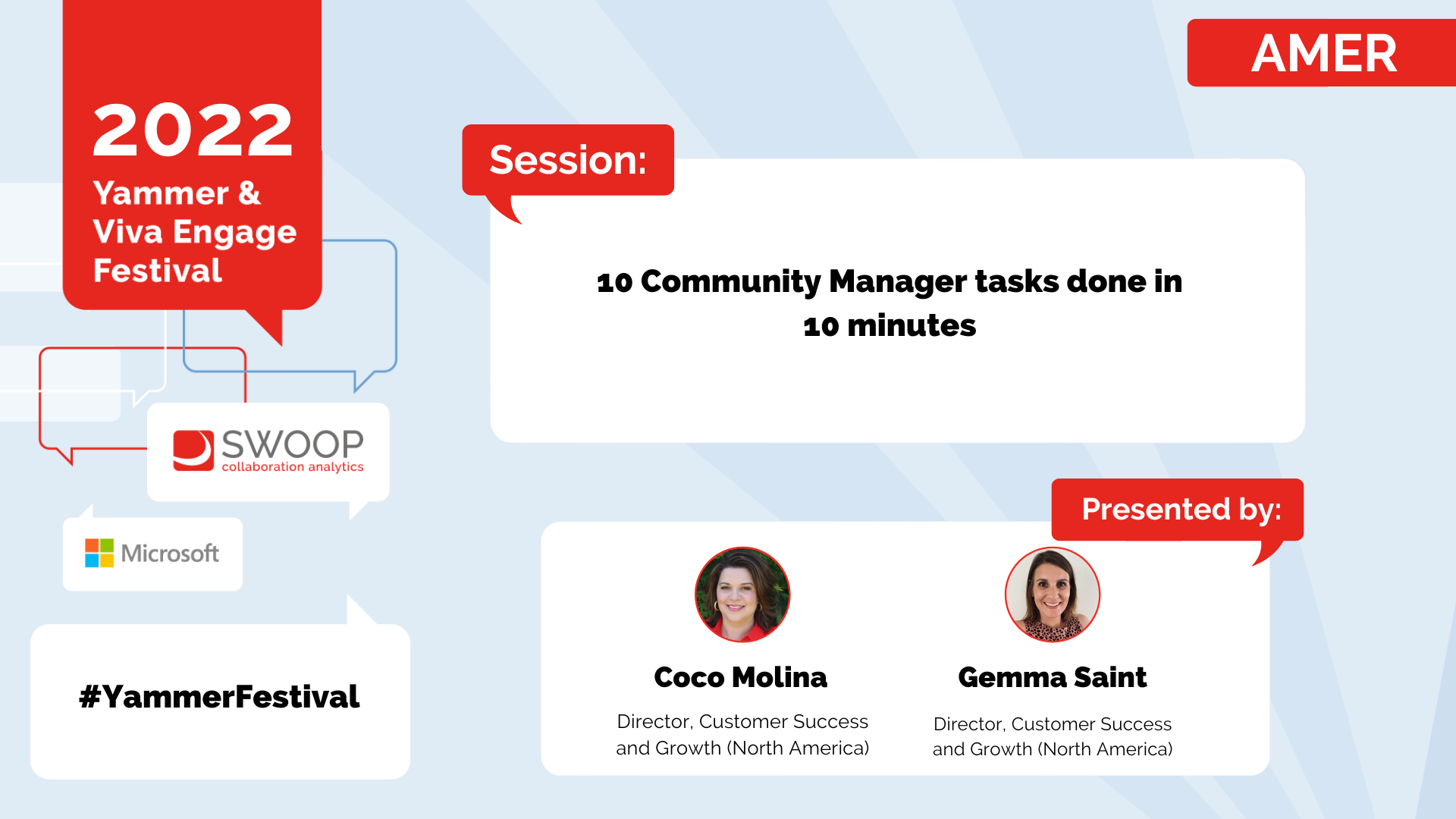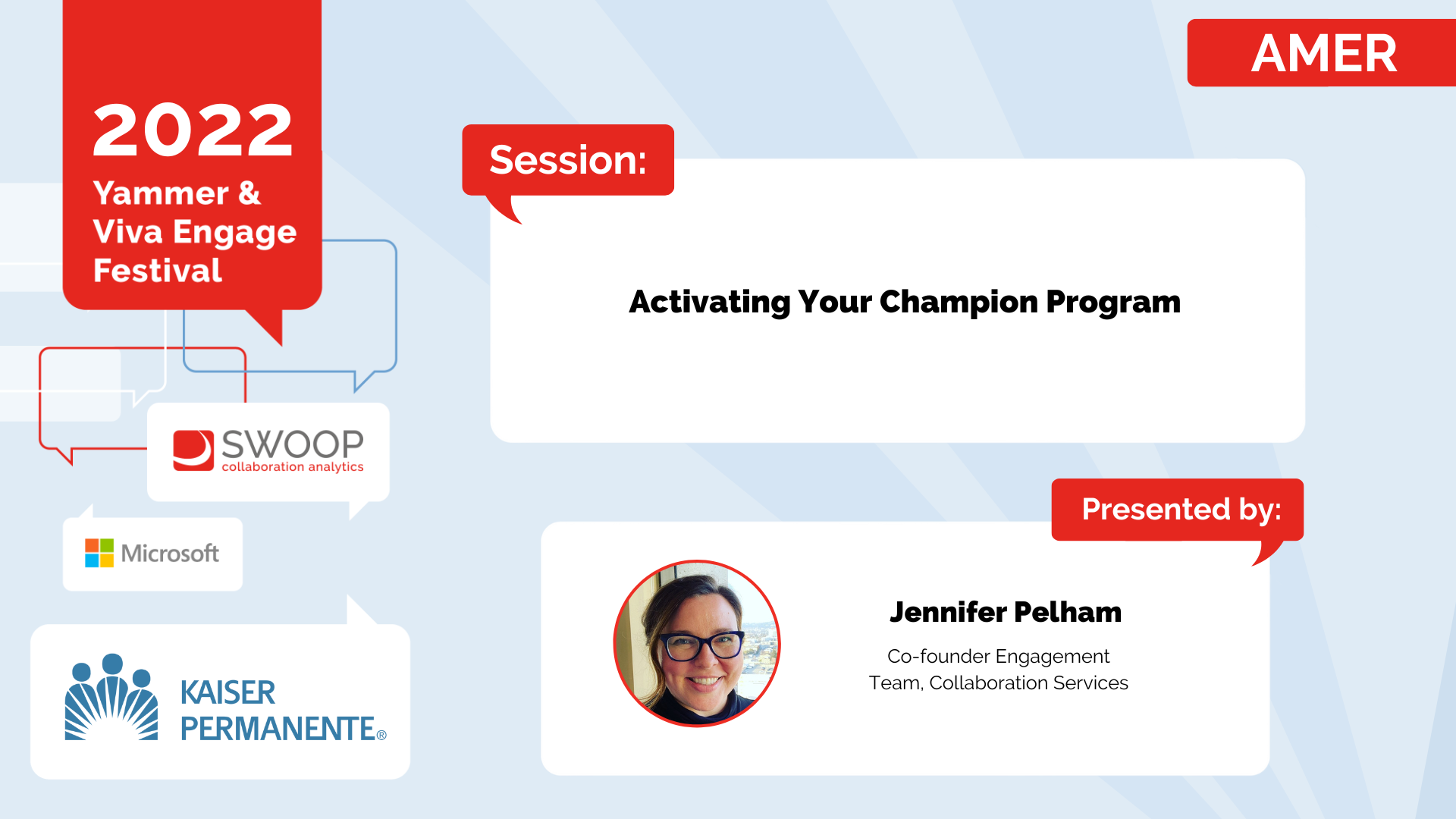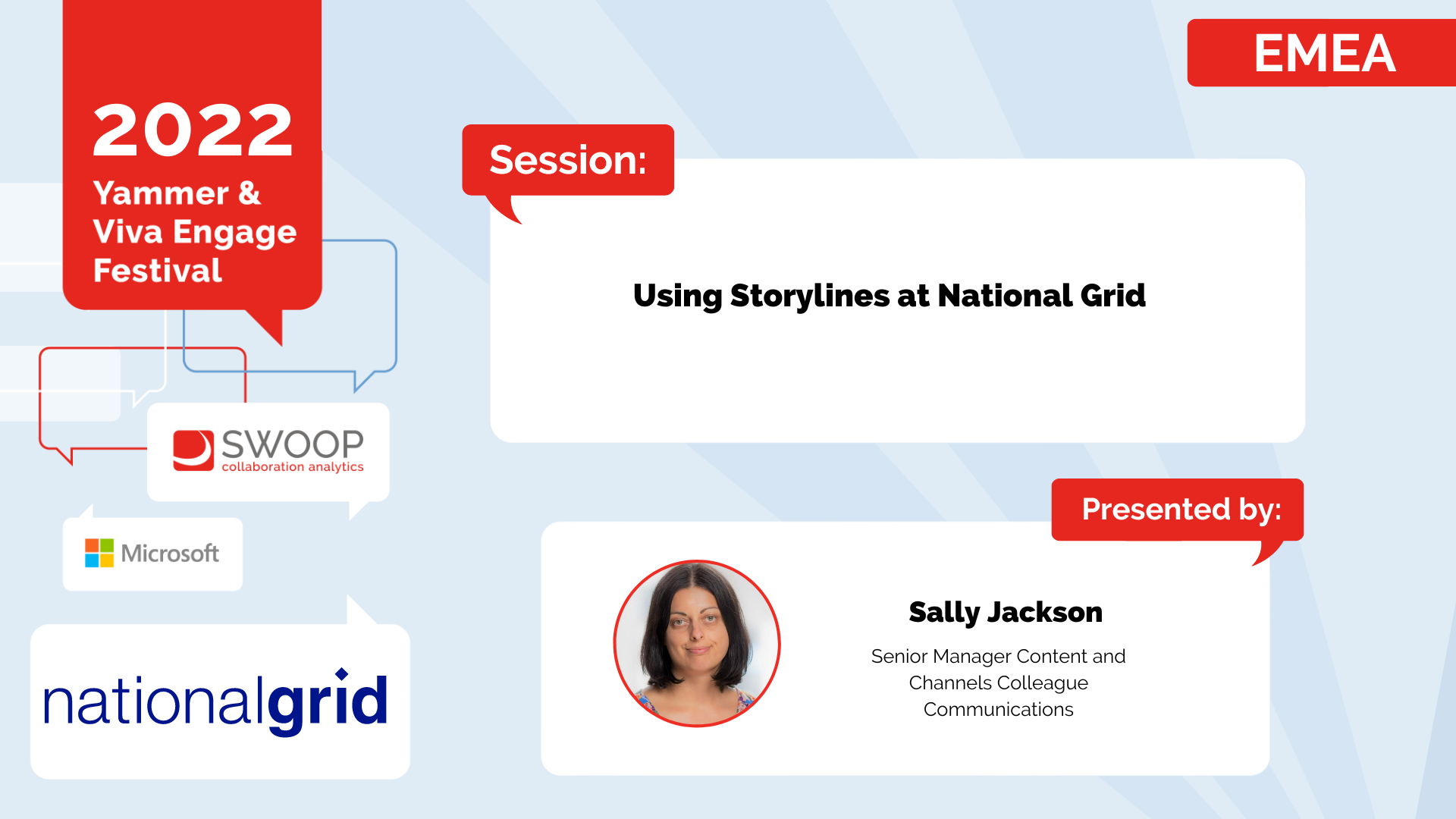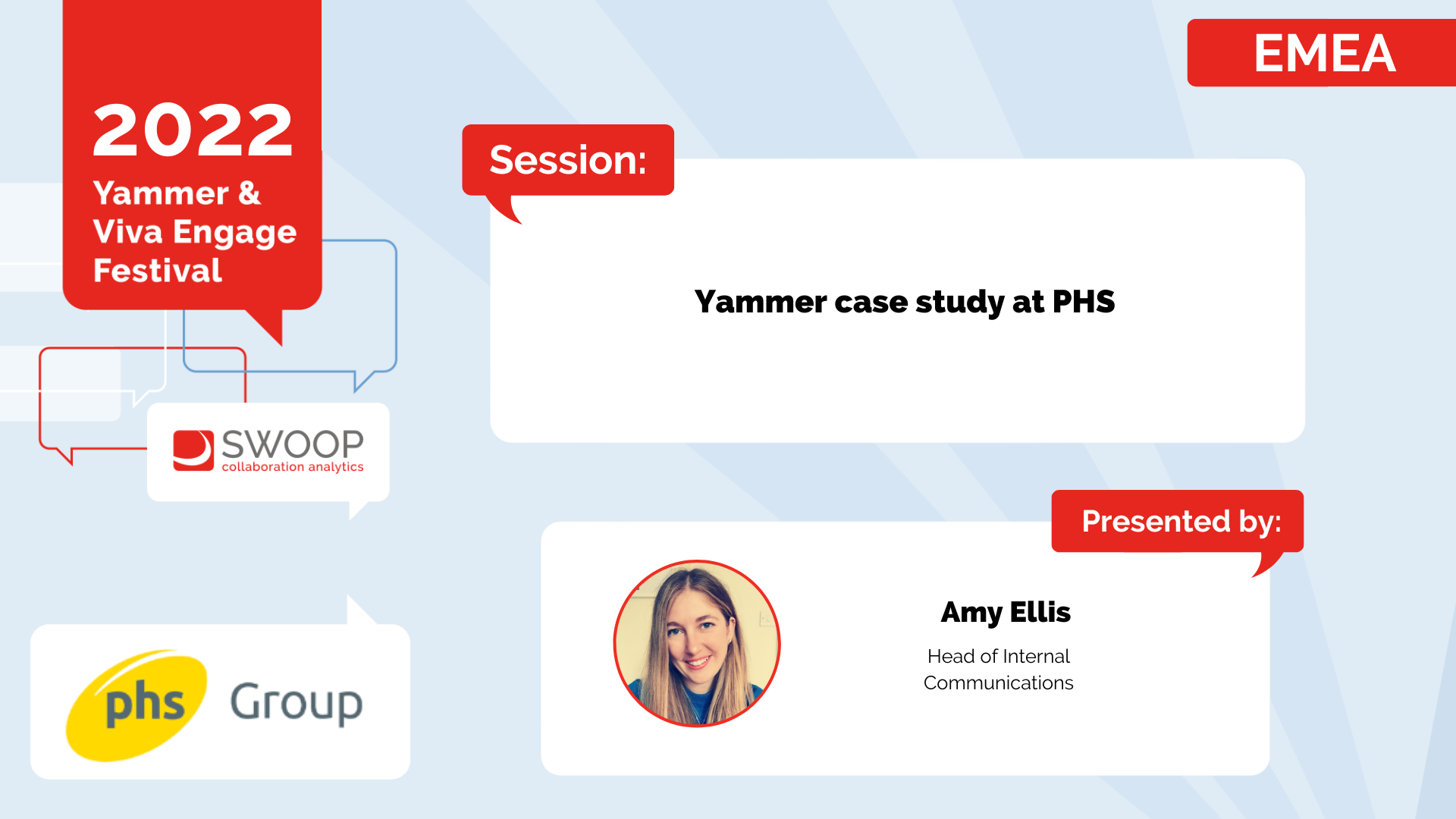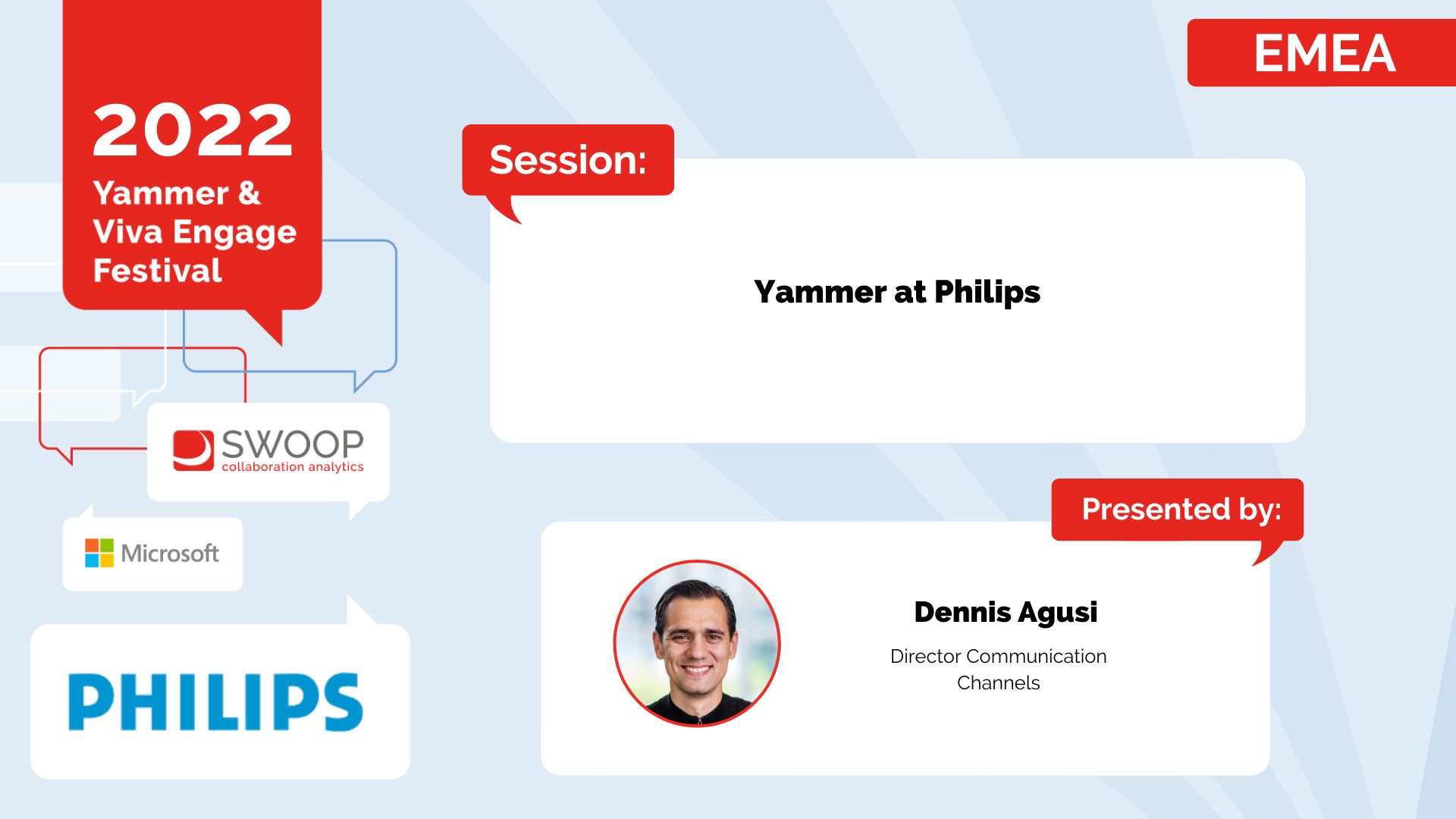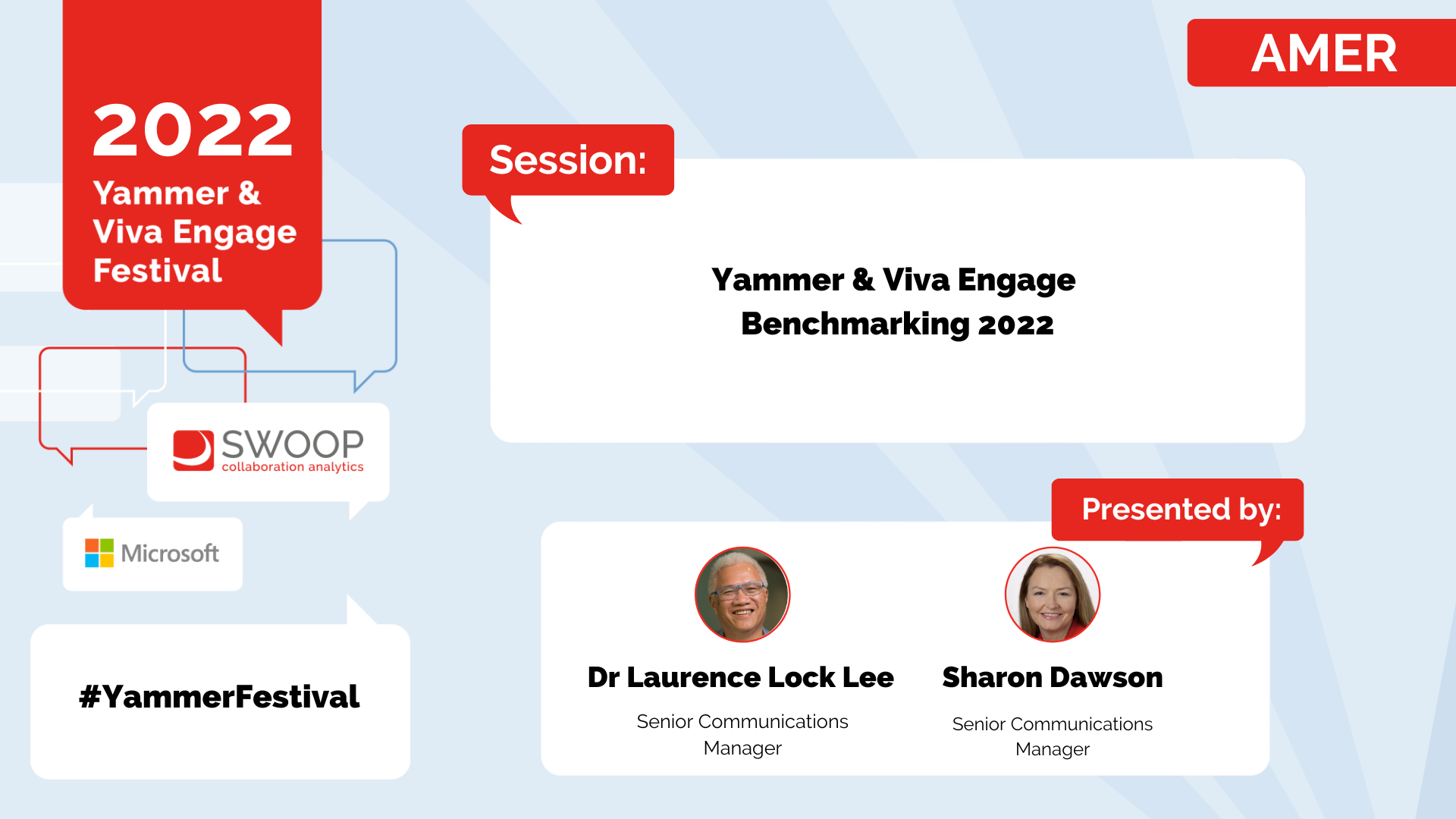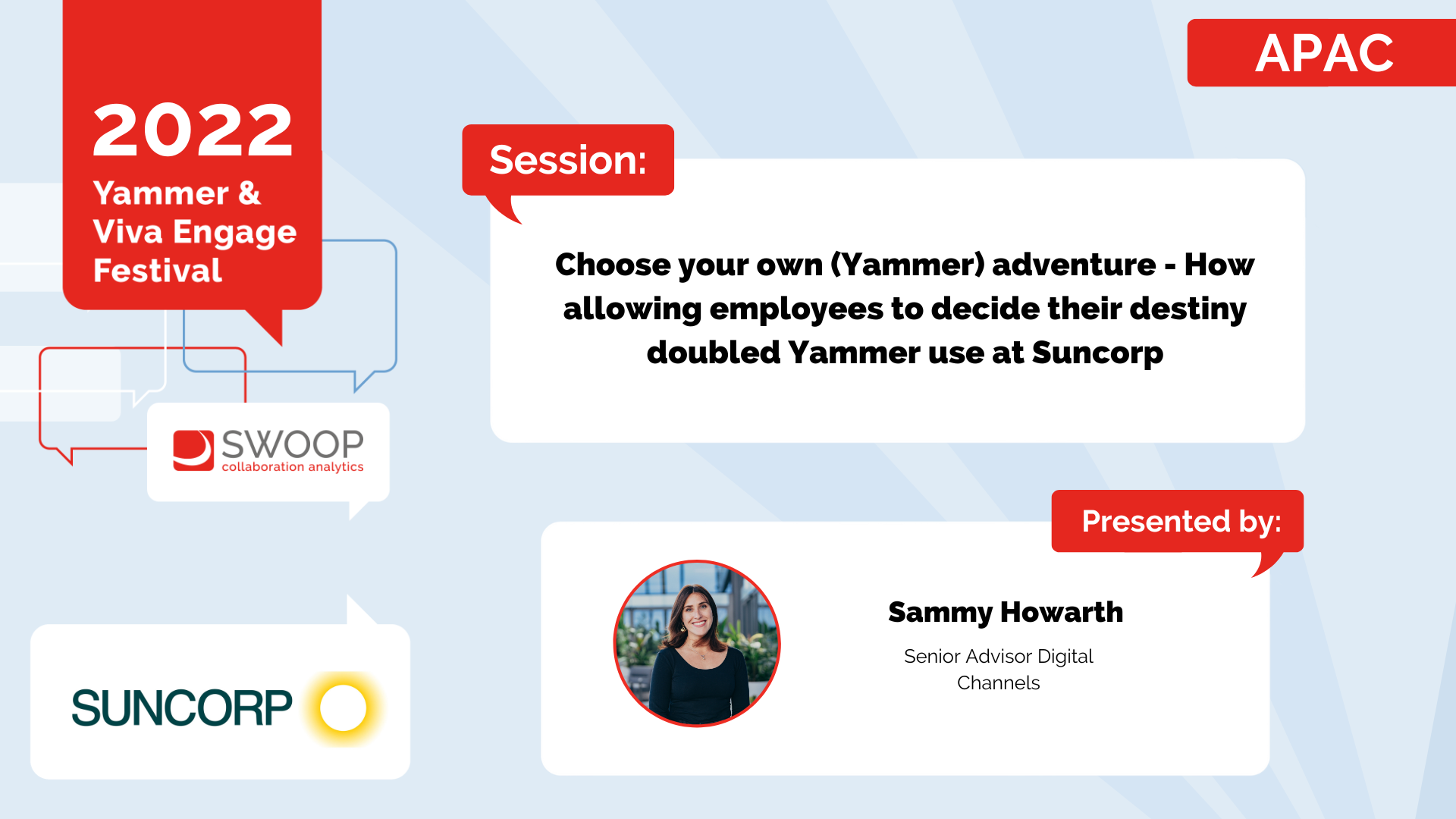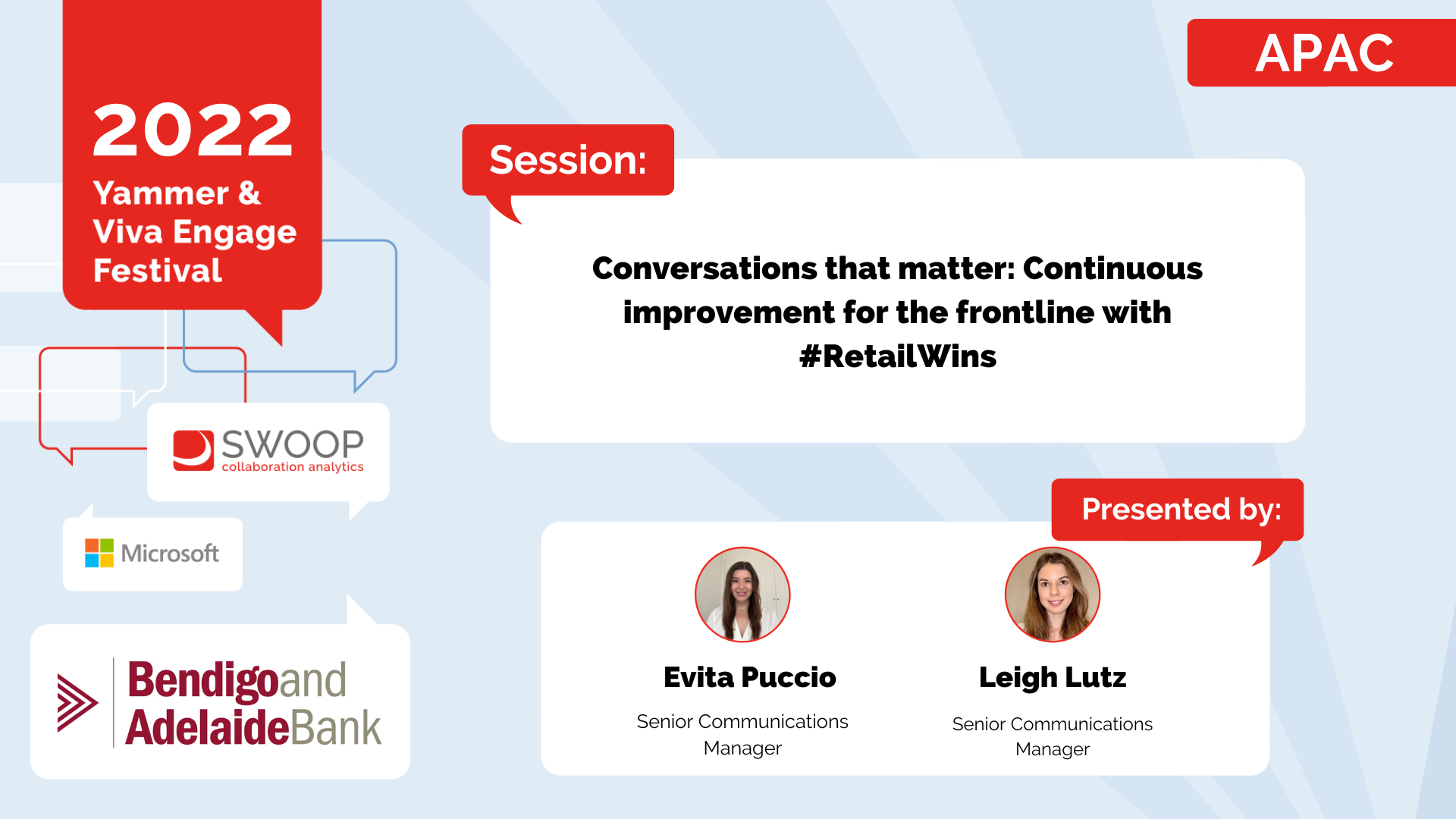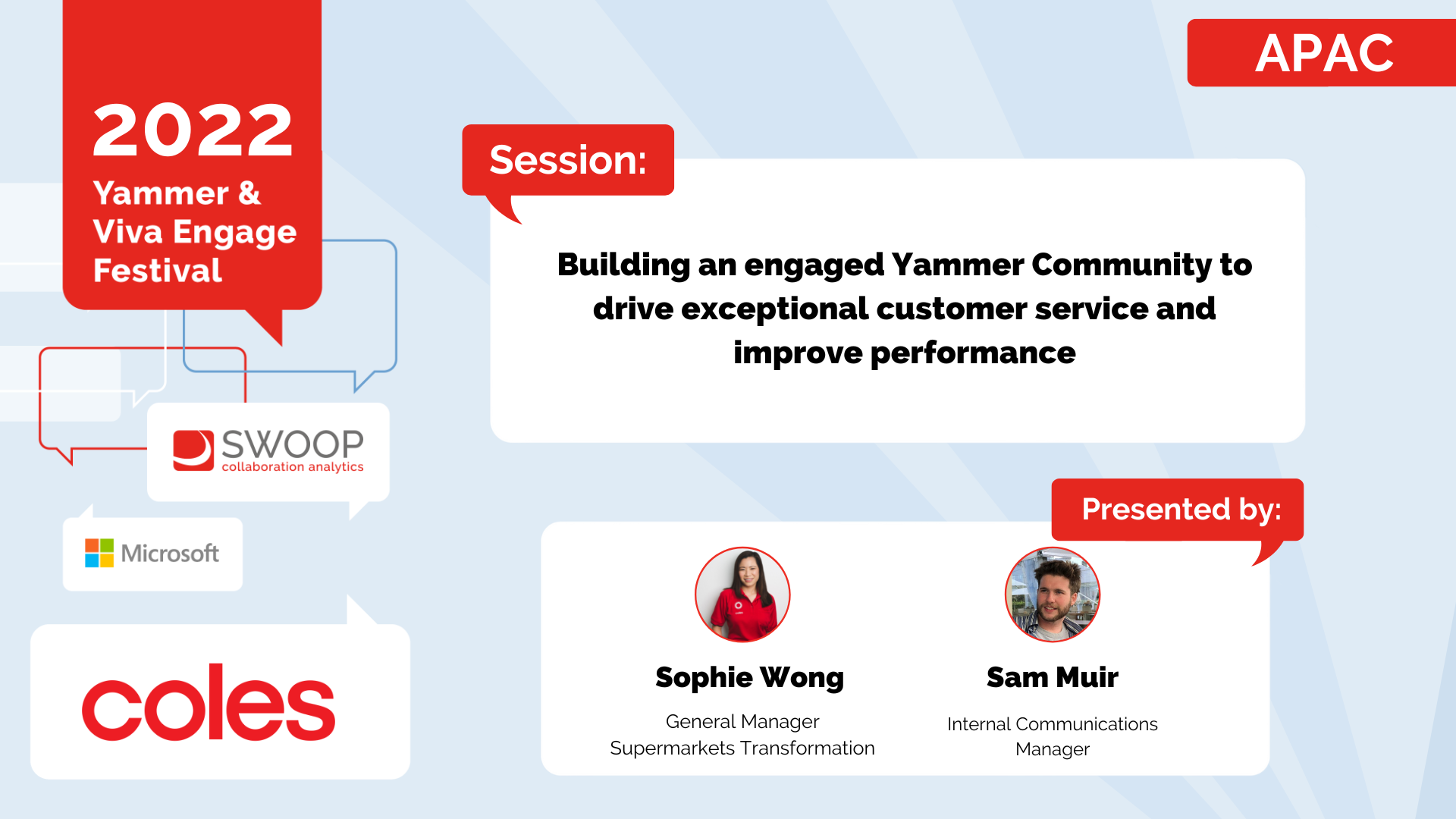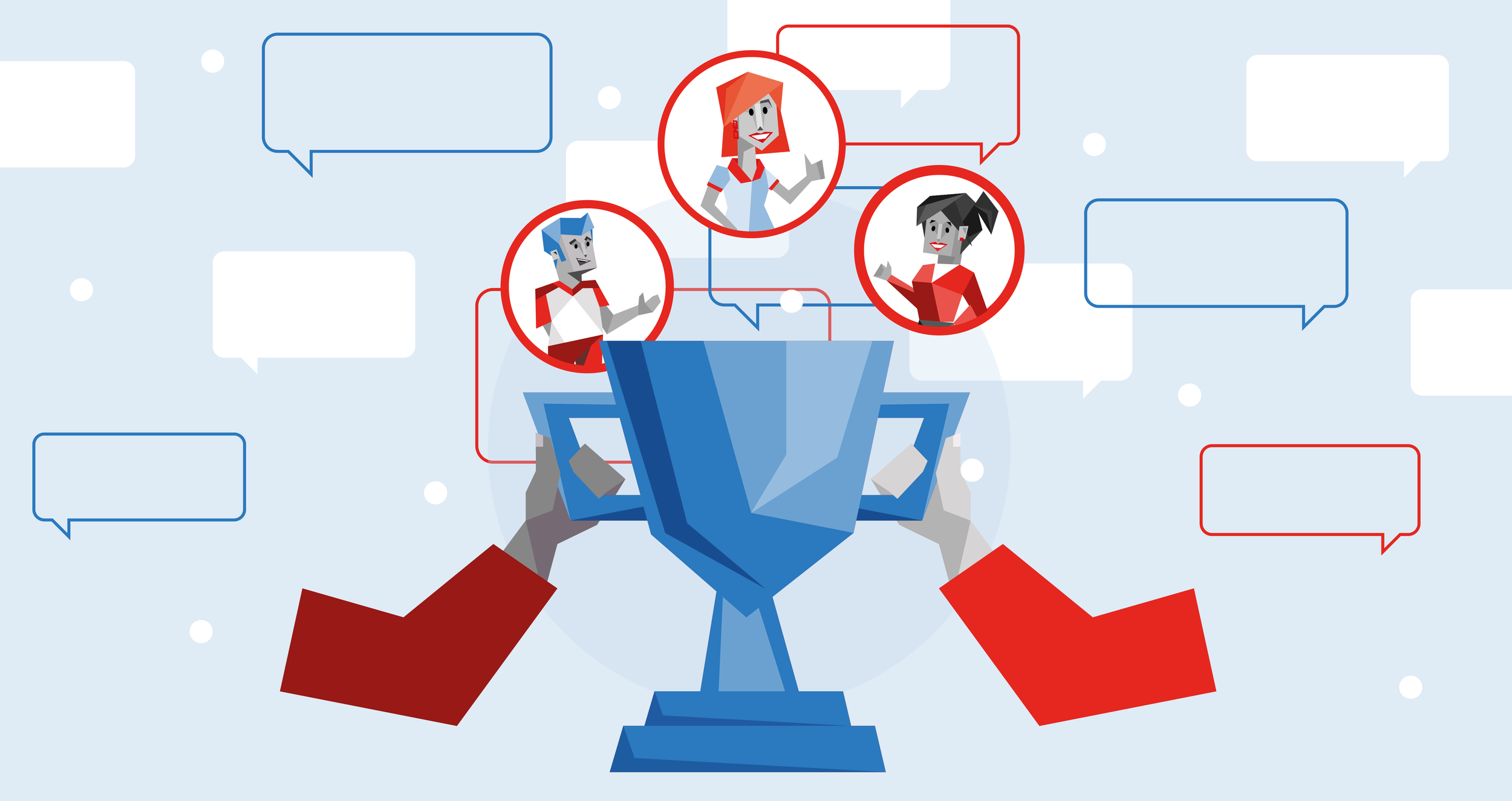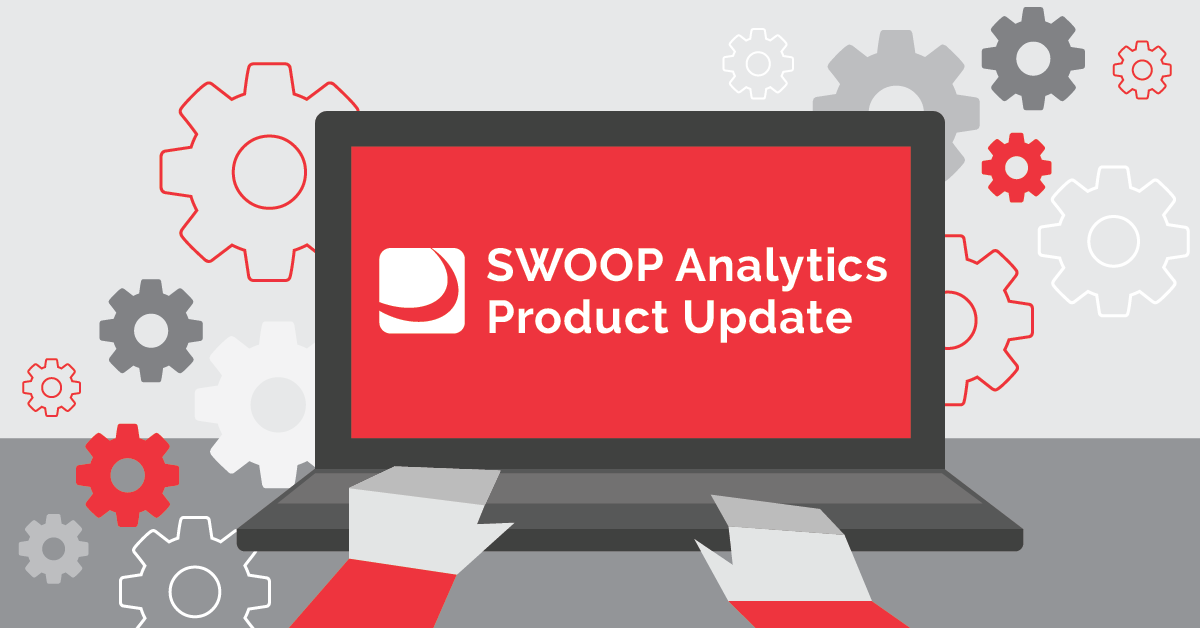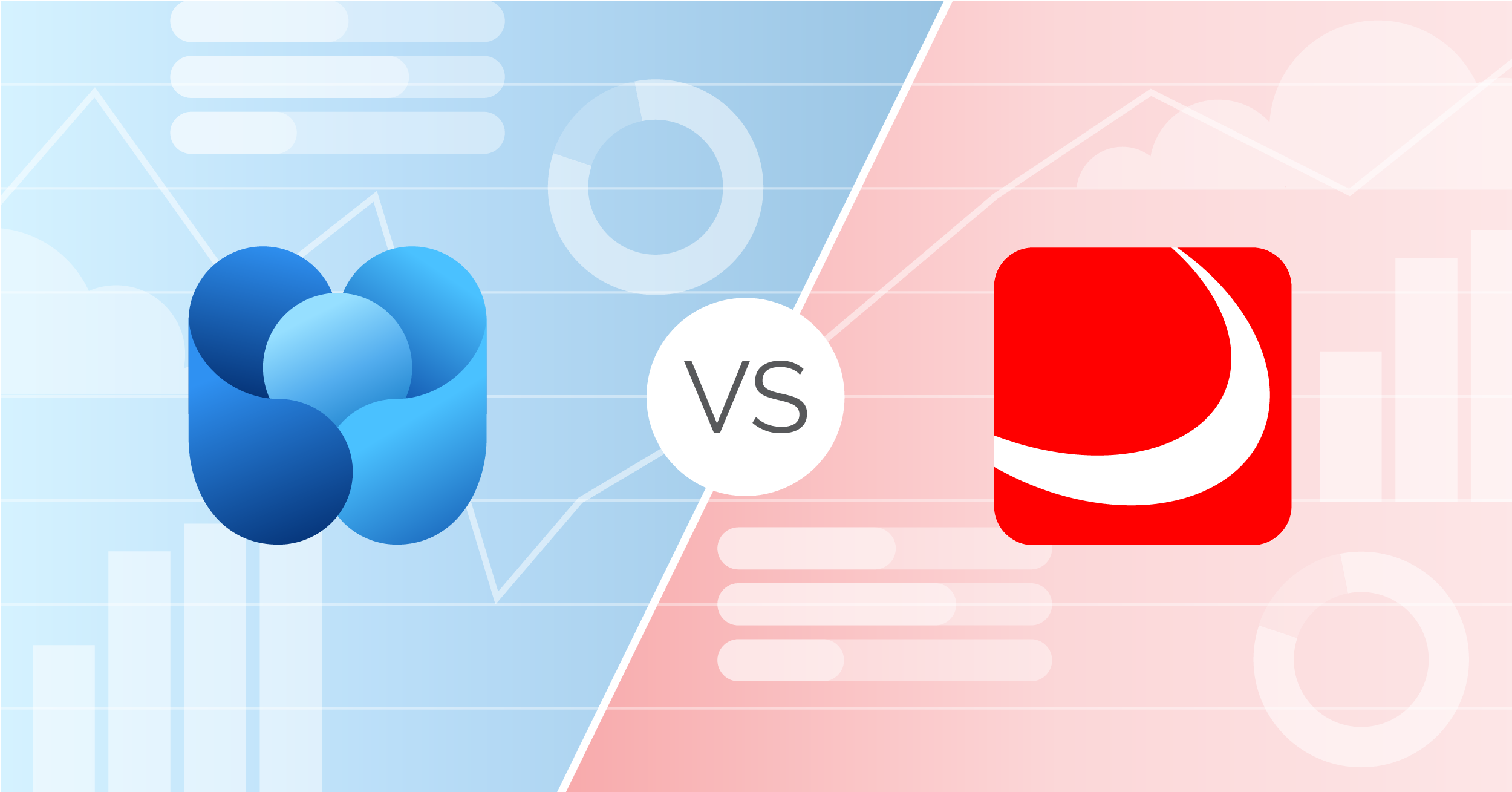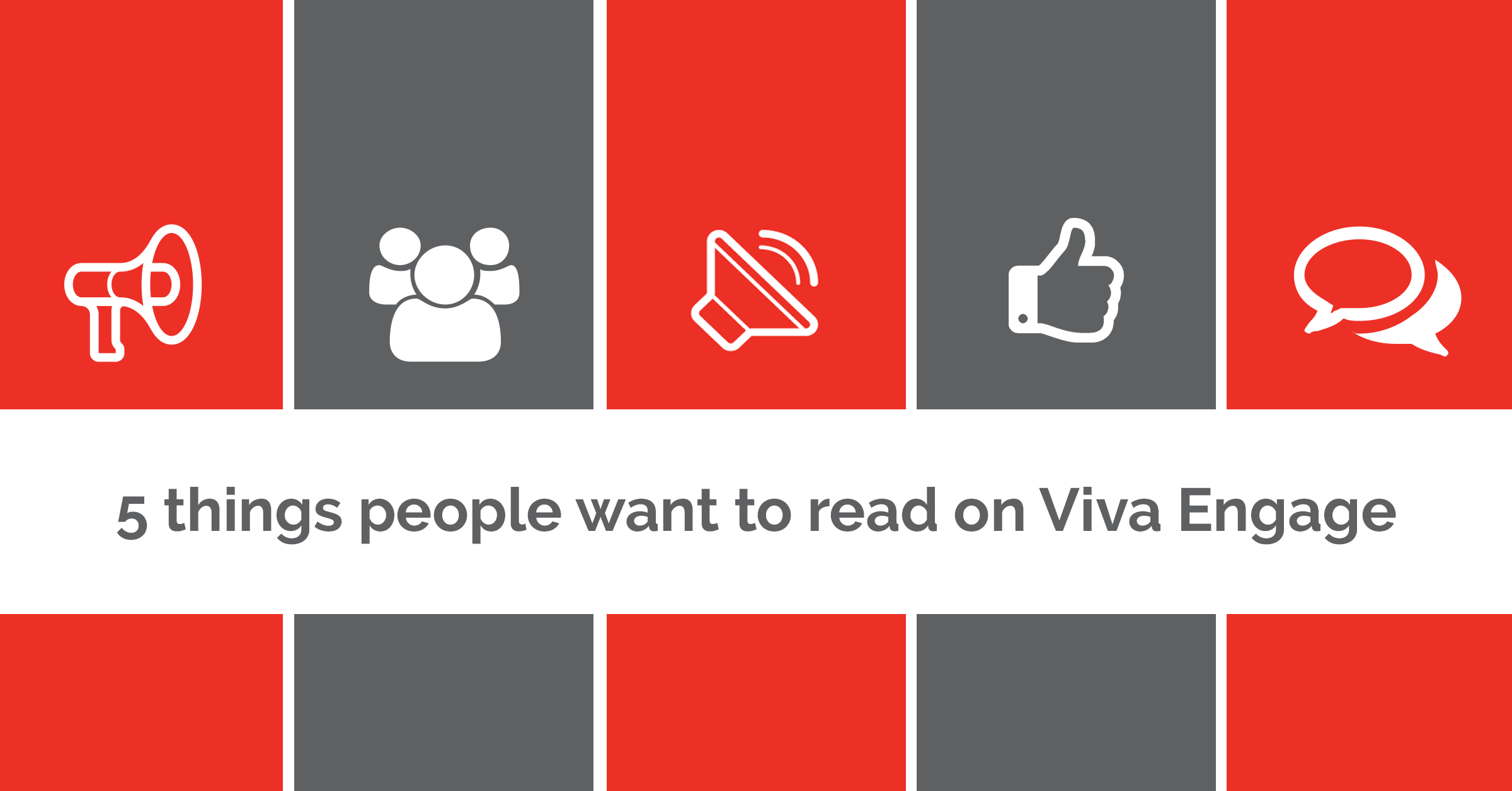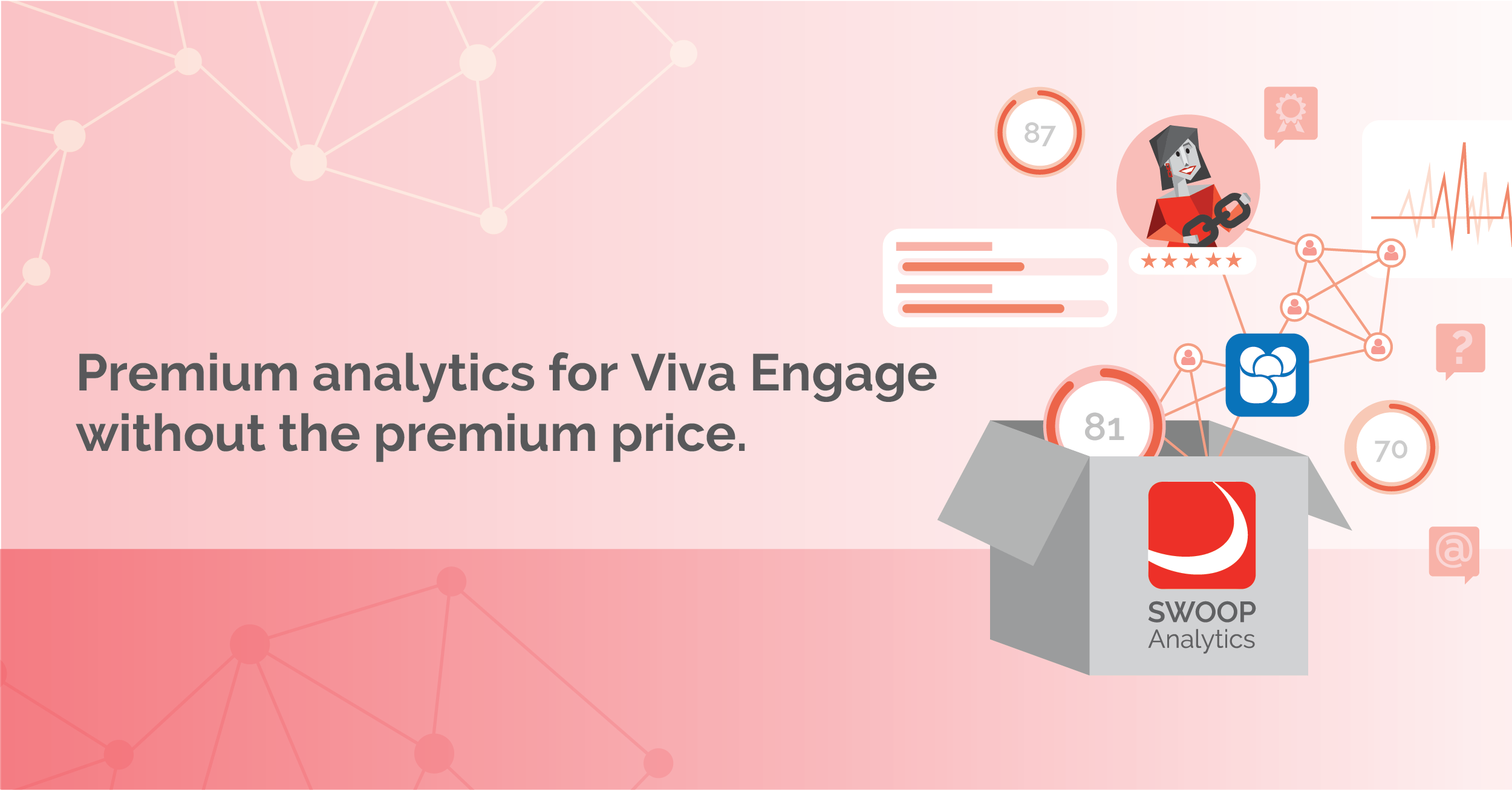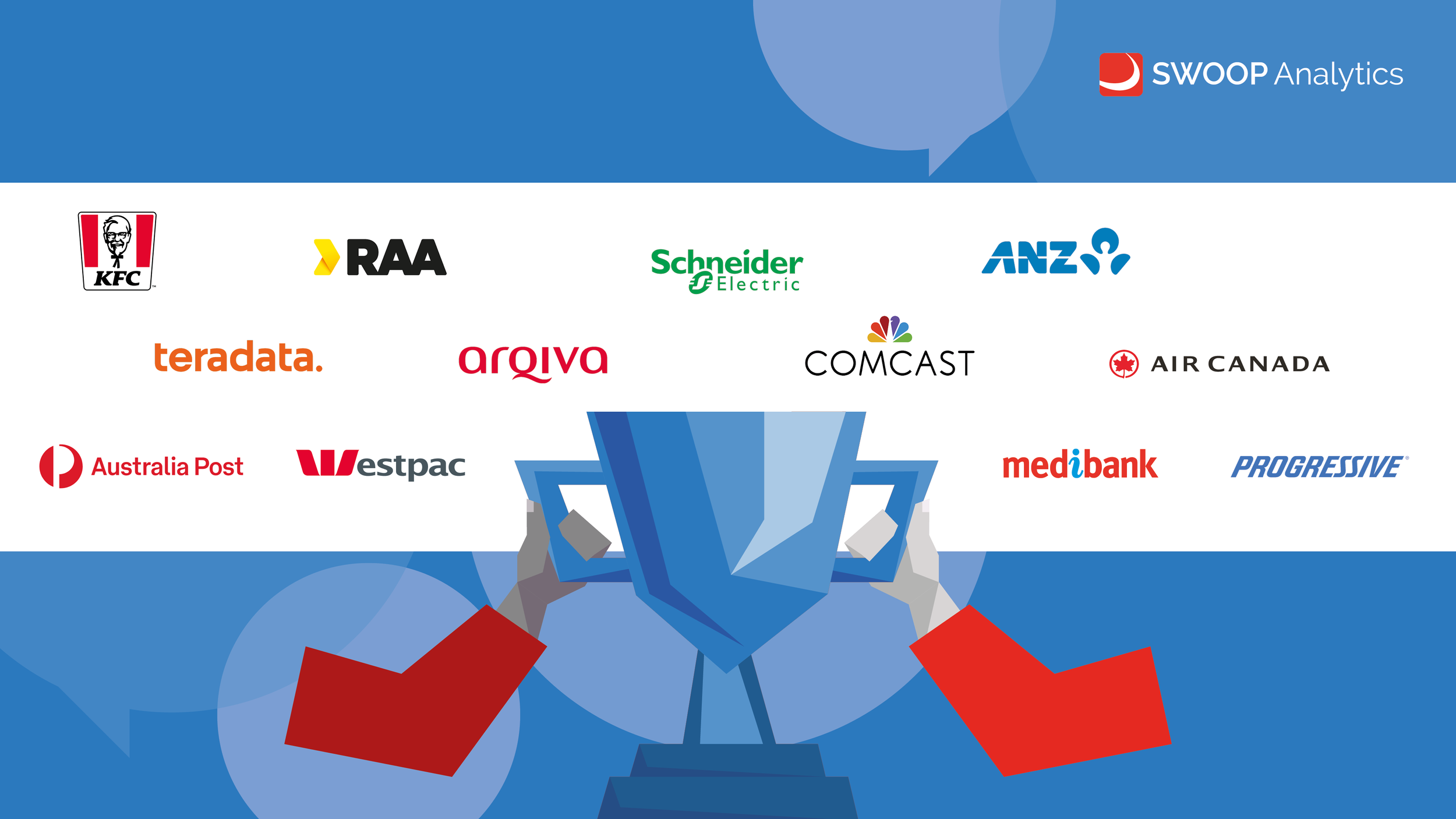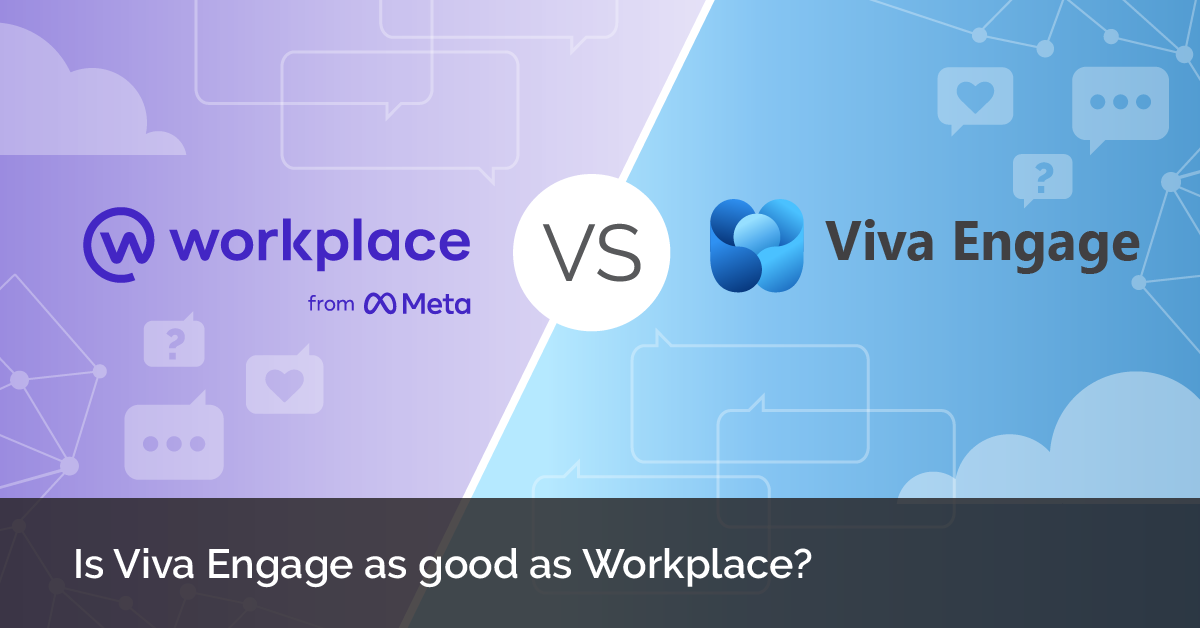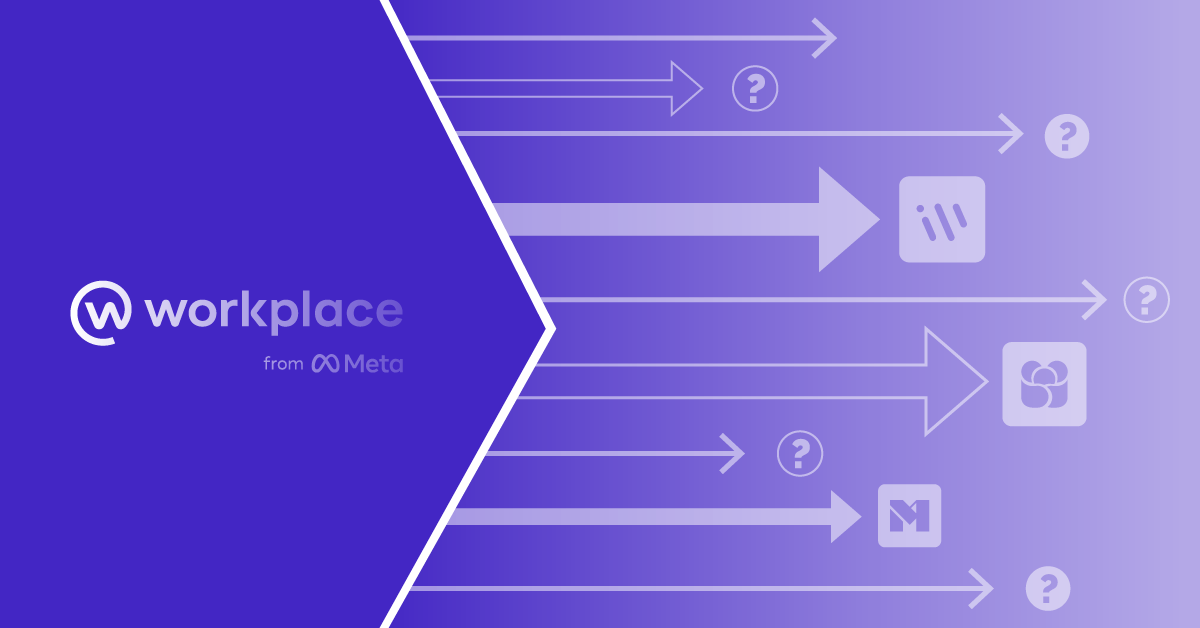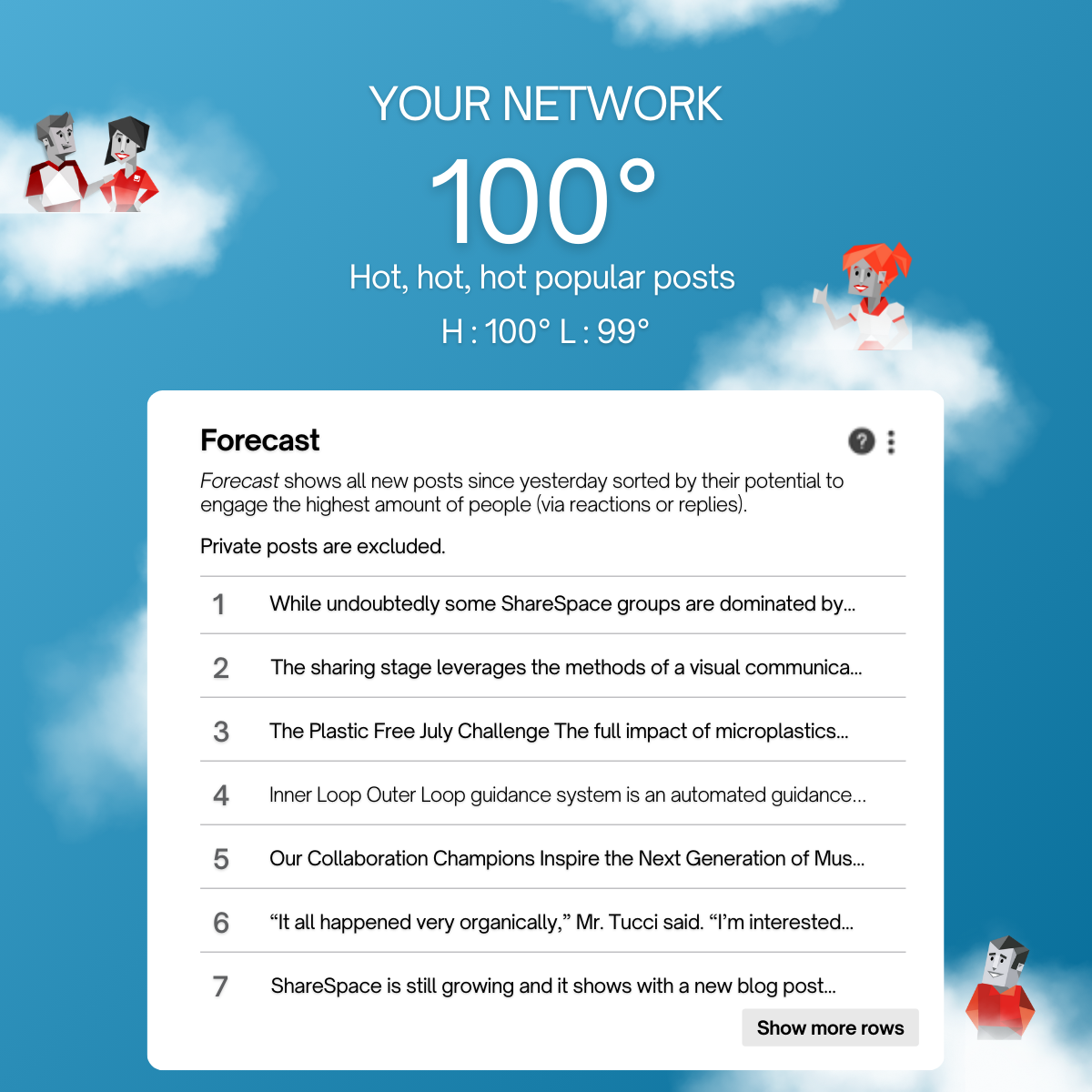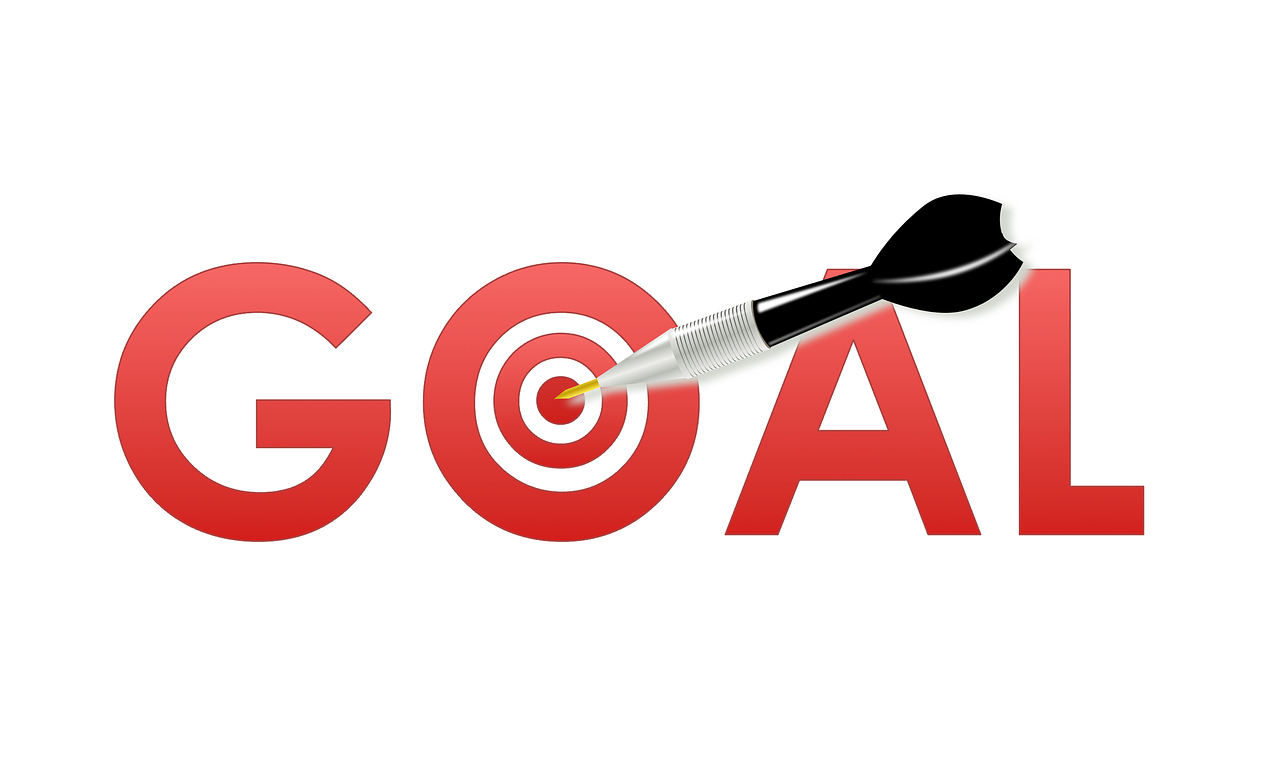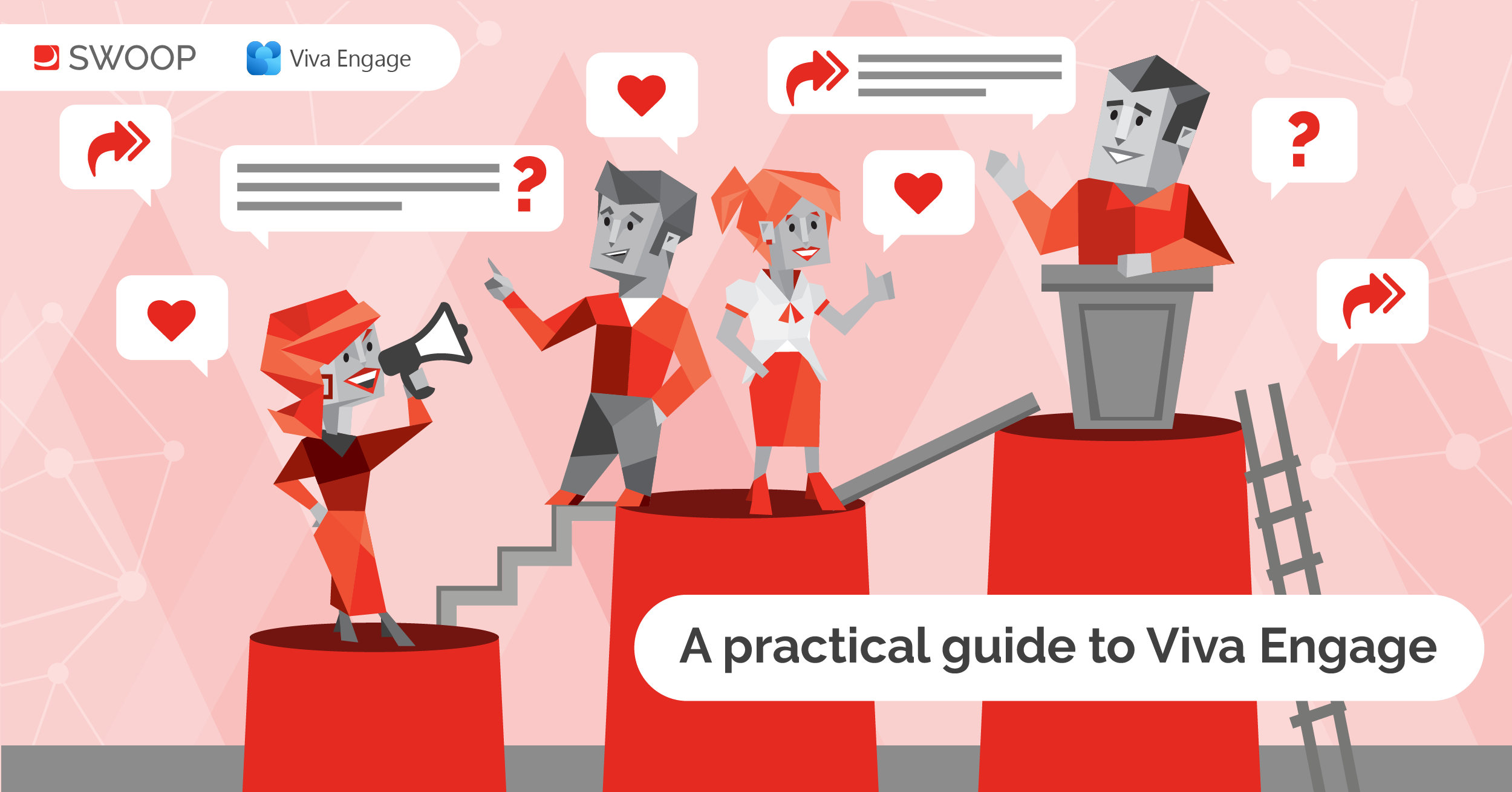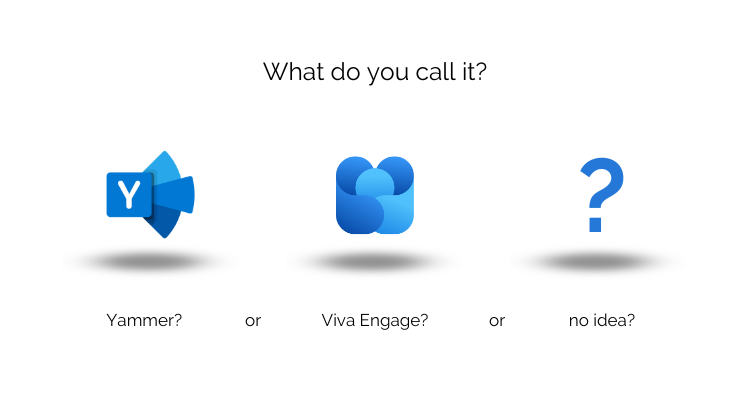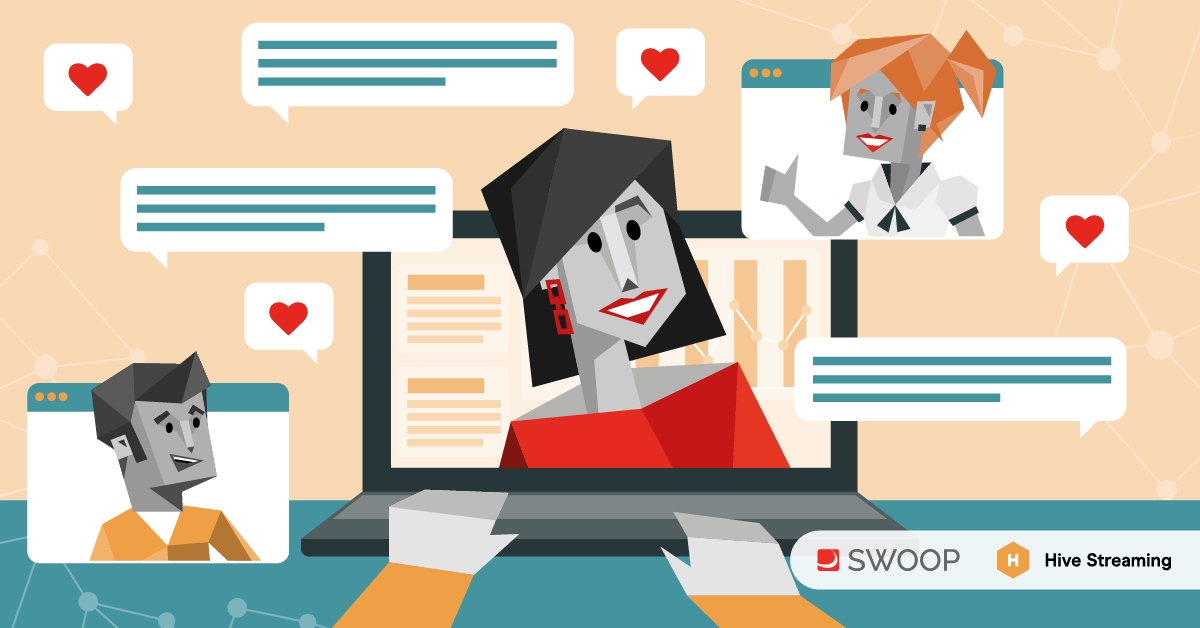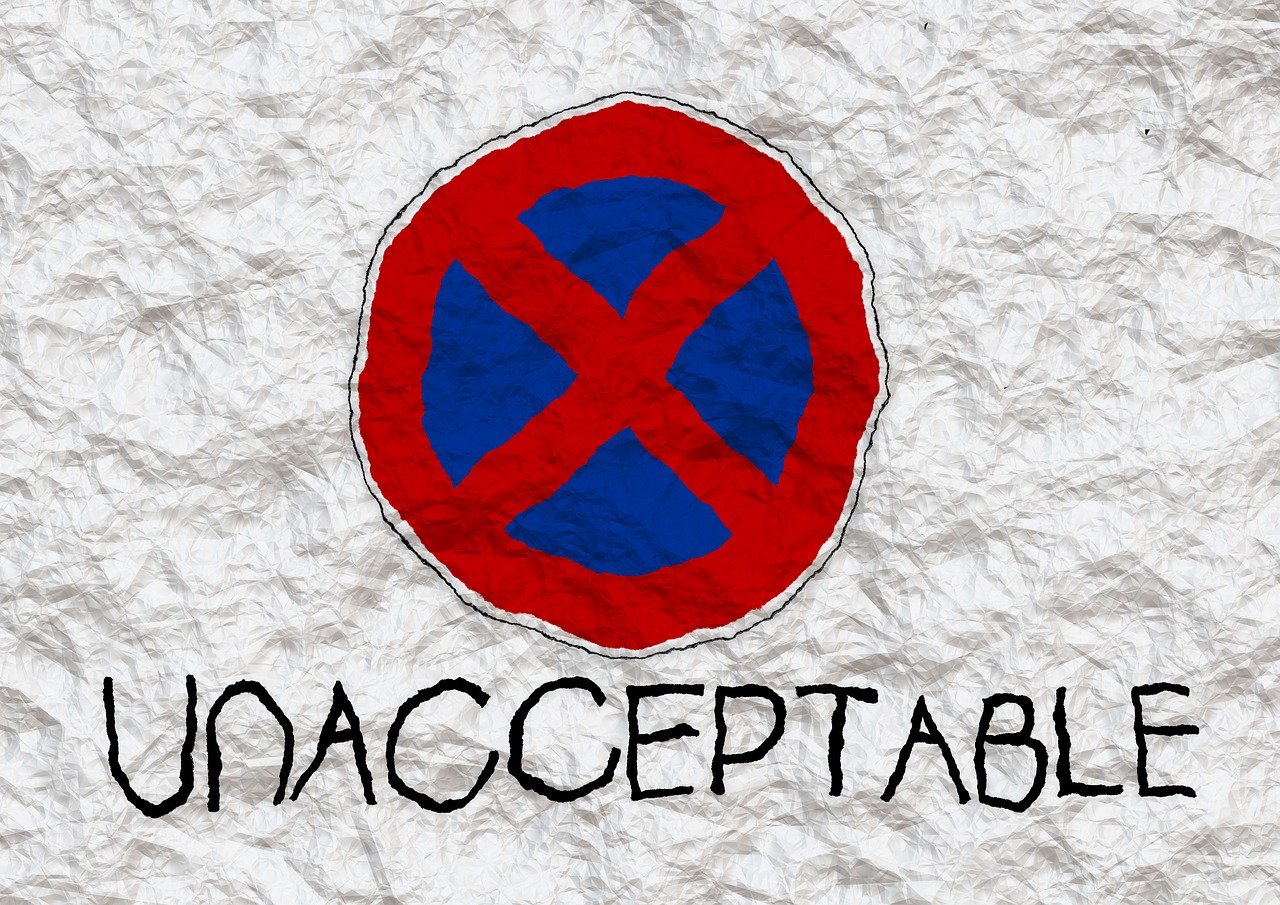National Grid: Using Storylines
EMEA | Yammer & Viva Engage Festival 2022
Join us and Sally Jackson from National Grid where she talks about the hottest topic in digital communication: Storylines on Viva Engage! Sally is sharing best practices, lessons learned and how to make the most of this new feature! Discover the discussion!
-
And introduce our next speaker. So Sally Jackson from National Grid, Senior Manager of Content and Channels, Colleague Communications. I think I've got the right title there, Sally.
And we're going to do things a little bit differently here. So, no, it's not going to be Sally just taking you through a presentation. We thought we've come to the end of a long issue event, although it's been amazing content.
Sally and I thought, well, let's just have a bit of a chat. So I've got a few questions for Sally. Sally is going to be talking about storylines.
So thinking back to the start to Nick's session, we talked about storylines and stories and the Microsoft roadmap with Yammer and Viva Engage. And Sally's been doing some innovative stuff at National Grid. So we're here to talk about storylines, I guess, to kick off.
What is it that you've been doing with storylines at National Grid? Thanks, Pete, and really great to see everybody today. I've been listening in and really enjoying hearing what other people are up to with Yammer and Viva Engage. So, yeah, great session.
Thank you. So we've had Yammer in place for quite a while now at National Grid. It's a core part of our channel set and we use it to support collaboration and two way conversation and kind of drive the conversational element on that we don't have on other platforms like our Internet.
So it works alongside those platforms. We switched on the storylines preview in end of September. I was really keen to try it out because of feedback that we'd had around Yammer and really keen to boost engagement and participation on the platform.
We've got really good levels of reach for our digitally connected colleagues, but quite low levels of participation. So I was really keen to kind of open it up and encourage more people on there and make it a really welcoming place that people felt comfortable posting on. And I saw that storyline was an opportunity for that, really.
So we launched it with quite simple activities, really, so promoted it across our intranet, in our weekly news roundup, ran a webinar for those interested. I posted about it in our Yammer Enthusiast community as well. So talked about it in there and quite low key, but kind of used the power of Yammer to promote it as well.
And then just kind of waited to see what happened, really. Yeah, cool. So you didn't you didn't have to break the bank and do any massive launch activity.
It wasn't overkill on this new functionality. No, I did it all myself. A couple of other people in the team.
So, for example, our Yammer launch post, I put something in all company to let people know about the webinar and what it's all about and explain what the purpose of storyline was. And got about 15,000 views of that post. So quite good reach.
And people started to use it straight away, actually. Also talked about it to some of our key stakeholders as well. So we've been doing promotion with our leaders and talked about the opportunity there with storyline for our leaders and with our colleague communications team as well.
And they've been really instrumental in driving engagement on the platform, but also been using and talking about storyline to their stakeholders as well. Yeah, cool. And I don't know how big this question is, really, but what have you seen and learned so far? OK, so a few interesting observations so far.
It's still early days, but we've seen that people who don't normally interact have started to dip their toes into the water on Yammer. And we have seen an increase in participation in the last quarter above kind of growth in visitor numbers, which is really, really fascinating. We've also used it alongside a big campaign that we ran around safety, which had kind of a user generated content element to it.
But this is really the first time that we've seen this level of engagement and interest where we've asked people to kind of share their stories on Yammer. It was a real step change. It's hard to say exactly how much of it is down to storylines, but certainly people did use the storyline functionality to share their own stories.
What we find is that we've got some smaller communities, but also some really big communities with up to around eleven and a half thousand members at times. So that can be quite an intimidating place to post for the first time or in your company. So, you know, it's another option for people and to share their own personal stories as well.
So made it clear it's not just about business information and business updates. You can use your storyline for things that matter to you. So we've seen people using it for sharing things like the safety campaign stories, but also just general little kind of anecdotes, pictures, pictures of their commutes or places where they're working.
Or we talk a lot about the weather in our organisation because we're an energy company. And, you know, in the in the US we have a big focus on on how we respond to storms. So people sharing their stories of the weather in upstate New York, for example, it just really helps connect people.
We're seeing motivational kind of thank you, praise posts as well on there, volunteering updates, general thought pieces. And I've even seen some very senior leaders on there as well, creating their own posts and responding to other people's storylines. And I think, yeah, I think with the leaders, there's more work to do there.
But I think with some of the some of the improvements that are on the way with Viva, so around the kind of leadership corner, for example, I think that kind of thing will really help kind of set storylines as a as a as a thing that we can use as part of leadership engagement approach more effectively to. And really kind of look at those, getting people to follow our leadership team. That leadership piece is really interesting as well, I think, where we see a lot of us have experienced leaders who are active on external social, like on LinkedIn.
They might be reasonably active on LinkedIn, where it's sort of the storylines functionality, I guess, aligns more to how, say, LinkedIn works. Maybe it's an easier step for a leader to start being active internally on Yammer if they've got this storyline functionality that's similar to what they experience externally. Do you do you do you think that that could be a play with those leaders who are now getting active with storylines? Yeah, definitely.
And we've also seen where we see examples of some posts actually on external social media. And we said there's an opportunity there to also be sharing those stories internally. And again, we did start to see we started to see that to happen now.
So one of our leaders who was at COP 27 recently, I saw, had posted something on their storyline about it. So I think it's starting to come together. Followers as well is another thing that we need to look at.
So that's been kind of used to a very limited degree because there were very few benefits to it for the kind of average Yammer user. But now with storylines, it really does help you kind of personalise that experience more. So obviously, if you follow people, not only are they more likely to surface in your home feed, but also you will see the updates on their storylines.
So and you can tailor for those of you who don't use storyline at the moment. You can tailor the way you receive those updates from the people that you follow. So it's really it's a really kind of nice way to have a bit more control over what what you're hearing about and who you're hearing from.
Another thing to mention about it is from from using it myself personally, is that it doesn't keep you closed in a bubble. So you might think, oh, you're only going to see the updates from people that you're following. But that's not actually the case because you have the option to toggle between looking at the people you follow specifically.
And also there's a general feed where it recommends content and trending content to you. And you will start to see posts from people that you've never, ever met before and start to learn about some things that you would just, you know, you wouldn't have heard about otherwise if you hadn't been on Yammer. So I think it's a fantastic opportunity to kind of break down silos in the organisation too.
And you get storyline roundup as well. I think it's actually on a weekly basis. That could be wrong there, but you get a roundup in Teams as well, which kind of reminds you to go in and have a quick look at what's going on.
One other thing that I mentioned that I wanted to mention, Pete, that when we're talking about this through the week is, again, this is quite anecdotal in my research at the moment. But what I'm seeing is the kind of the ratio of people who are reacting and commenting on a post to the number of views is actually growing. So, you know, if you post something in your company and you get 10,000 views on it, you might only get eight or ten likes or comments, depending on what it's about.
But on a storyline post, maybe you get about 200 views, but you know, you're getting more comments and reactions because I think people feel safer doing it there than in your company. So potentially, there's a sort of proportional response improvement with a storyline. I think that might be the case.
Yeah. So obviously, there'll be more to see on that. Yeah.
Interesting to see the data on that. If we can run the numbers on that, that would be really cool. Yeah.
I do want to just drill in a little bit. You've mentioned a couple of times the safety campaign. One of the things I'm wondering is if the introduction of storylines might require comms people in particular to look at how to structure a campaign and what a campaign might look like.
So do you think you could share a little bit of info on this safety campaign that you've mentioned as how that was run? Why storylines was a component of that? So we want, first of all, we kind of came at it from two angles. We really wanted to drive engagement on Yammer because we see it as a really, really useful business platform. But also we had a desire to drive engagement in this particular campaign.
It's a massive priority for our organisation, as for many. And we really wanted people to kind of get involved and feel part of it. And it was the kind of one week of the campaign was about, you know, having discussions and sharing your story.
So Yammer felt naturally like the right platform for that. What we really needed to do was set people up for success and encourage them. So we kind of run a viral campaign where we started off with some key people, ask them to mention others and encourage them to share their stories.
And it kind of built from there. And we saw much higher levels of engagement than we'd ever seen before in that kind of campaign. It was partly because of the kind of getting things set up and supporting our leaders to kind of kick off the activity as well.
So people see leaders getting involved in it really helped. We also had kickoff call for all of our managers about the overall campaign. And again, you know, they felt more involved and empowered to kind of get involved and share content.
And we also gave people some materials that they could use on Yammer to make their post stand out. So we call them cards, but, you know, any kind of imagery that people can edit and add to their post. People tend to love that kind of thing.
So, yeah, I think that also really, really helped. People felt that there was something that they could kind of base their post around rather than just writing a few words and thinking it might get lost. And it made the post really stand out in terms of how we run the campaign.
And we do that. We're starting to do this for all of our big campaigns where Corrie Communications is involved, is that we also are using topics as well. So it allows people to follow the topic, to see content wherever it sits, whether it's on a storyline or in a community.
And kind of helps people, you know, pull that content together. It gives us better visibility of what's happening across the platform as well. And so we'll definitely be using more of those.
So the messaging in this safety campaign was kind of, you're able to say share wherever you like. Like in Yammer, use storyline, use a relevant community. Just share the message.
Exactly. It was more about, you know, share it, share it with your colleagues. It doesn't matter where it is.
And I actually think with Yammer, I think we can, we can think in two siloed away, there's crossover between communities. So, you know, it's not one or the other with storylines and communities and both of those things can work together. So, for example, I posted about coming along and speaking this event today on my storyline.
So I thought actually my own contacts might be interested in that. Maybe people in the Corrie Communications team. Hopefully there are a few on here.
And, and, you know, I also shared that post into the Yammer Enthusiast community because I thought that particular group might be interested too. So I do think it's not a one or the other. Right.
We've got a couple of minutes left and I just want to ask one final question, which is obviously you've, you've been experimenting. What would you like, like to see over the year ahead as it sort of gets a bit more solid for you? OK, so there are a few things that are coming and I would like to say that I think will really help with this. So we need to think about how we use this as part of our big campaigns to help kind of drive usage, provide more support to colleagues on how to use functionality.
Stories, which is the new content type that's coming soon next year. Really excited about that. And I can see some clear kind of use cases for that kind of short form, snappy, temporary content, which is a bit more fun and visual and engaging.
And I do think that will be an opportunity and we'll be able to use that to drive storylines more. And I think the leader functionality as well will help. So we'll do a piece of work around that, getting leaders on there and get people following our leaders more.
And then around analytics is for me the big gap at the moment. So I really like to get a better understanding of how storylines is performing, how people are using story content type as well will be another one for me. So getting the numbers to show what's working and what isn't so we can keep shaping our approach.
Yeah, no, so I think I think you're like what you see of what SWOOP is developing to help understand that. So thank you so much for sharing. I think a lot of people are kind of still in that space of trying to work out what storylines mean.
So it's super helpful to have yourself jump on here and just share what you've experienced. I think it's a really positive message and lots that you've learned. And again, it comes to that thing.
There's a thread around doing stuff and observing and learning and experimenting and see what happens. Exactly. It doesn't have to be perfect.
And that's kind of the approach that we take in our in the development of our channels that, OK, we need to do things that are based around the user needs. But ultimately, let's give things a try and build on it and we can evolve as we go. So I certainly don't regret switching on the storyline functionality at all.





